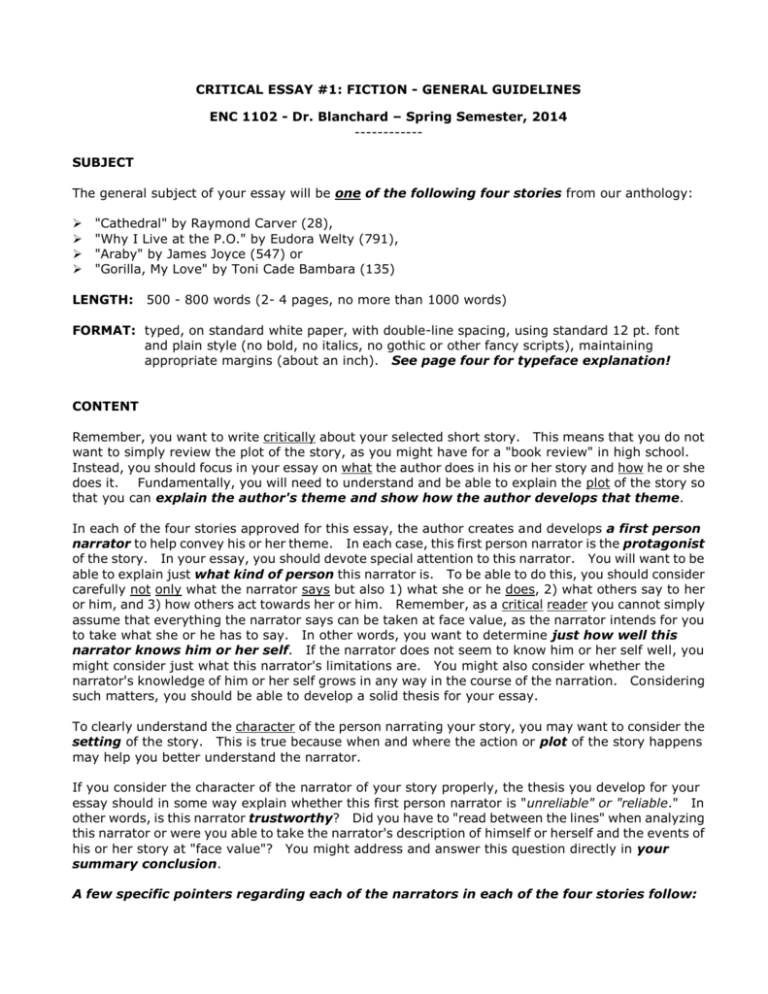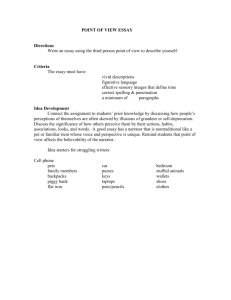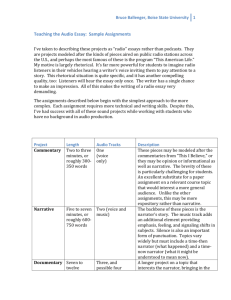Critical Essay #1
advertisement

CRITICAL ESSAY #1: FICTION - GENERAL GUIDELINES ENC 1102 - Dr. Blanchard – Spring Semester, 2014 -----------SUBJECT The general subject of your essay will be one of the following four stories from our anthology: "Cathedral" by Raymond Carver (28), "Why I Live at the P.O." by Eudora Welty (791), "Araby" by James Joyce (547) or "Gorilla, My Love" by Toni Cade Bambara (135) LENGTH: 500 - 800 words (2- 4 pages, no more than 1000 words) FORMAT: typed, on standard white paper, with double-line spacing, using standard 12 pt. font and plain style (no bold, no italics, no gothic or other fancy scripts), maintaining appropriate margins (about an inch). See page four for typeface explanation! CONTENT Remember, you want to write critically about your selected short story. This means that you do not want to simply review the plot of the story, as you might have for a "book review" in high school. Instead, you should focus in your essay on what the author does in his or her story and how he or she does it. Fundamentally, you will need to understand and be able to explain the plot of the story so that you can explain the author's theme and show how the author develops that theme. In each of the four stories approved for this essay, the author creates and develops a first person narrator to help convey his or her theme. In each case, this first person narrator is the protagonist of the story. In your essay, you should devote special attention to this narrator. You will want to be able to explain just what kind of person this narrator is. To be able to do this, you should consider carefully not only what the narrator says but also 1) what she or he does, 2) what others say to her or him, and 3) how others act towards her or him. Remember, as a critical reader you cannot simply assume that everything the narrator says can be taken at face value, as the narrator intends for you to take what she or he has to say. In other words, you want to determine just how well this narrator knows him or her self. If the narrator does not seem to know him or her self well, you might consider just what this narrator's limitations are. You might also consider whether the narrator's knowledge of him or her self grows in any way in the course of the narration. Considering such matters, you should be able to develop a solid thesis for your essay. To clearly understand the character of the person narrating your story, you may want to consider the setting of the story. This is true because when and where the action or plot of the story happens may help you better understand the narrator. If you consider the character of the narrator of your story properly, the thesis you develop for your essay should in some way explain whether this first person narrator is "unreliable" or "reliable." In other words, is this narrator trustworthy? Did you have to "read between the lines" when analyzing this narrator or were you able to take the narrator's description of himself or herself and the events of his or her story at "face value"? You might address and answer this question directly in your summary conclusion. A few specific pointers regarding each of the narrators in each of the four stories follow: ENC 1102: Critical Essay #1 - Guidelines (2) "Cathedral": the narrator of this story never states his name. Though Robert, the blind man who is a close friend of the narrator's wife and who visits, calls him "bub," this is not his name any more than “dude” is somebody’s name. You should refer to the narrator, then, as “the narrator.” You will want to consider when writing critically about this story whether Robert teaches the narrator to see in ways he hadn't ever seen before and, if so, what or how the narrator begins to see. The title of the story suggests that Carver is using the image of a "cathedral" symbolically in some way. In developing your thesis for this essay, you should consider just how the image of a cathedral may explain what the narrator learns from Robert. "Why I Live at the P.O.": Sister, the narrator of this story, has moved out of her family's home in China Grove, Mississippi and is living at the post office where she serves as post mistress. The story is basically her explanation as to why she's moved into the post office. When writing critically about this story you will want to analyze Sister’s words closely. You should describe Sister's feelings toward her younger sister Stella Rondo and consider how Sister's feelings may influence her interpretation of events. You should ask yourself, certainly, why Sister is so insistent that Stella Rondo's daughter Shirley-T is not adopted but, rather, is Stella Rondo's biological child. The fact that the action takes place in rural Mississippi about 1940 may be relevant to this question. If you can explain why Sister wants to believe Shirley T is Stella Rondo's biological child, you probably have a fairly good idea of the kind of person Sister is. "Araby": the boy narrating this story is never named and neither is the young woman about whom he finds himself fantasizing. She is simply the sister of Mangan, one of the narrator’s friends. However, this does not present the narrator from clearly explaining what will probably be one of the most significant experiences of his life, no matter how long he may live. In your essay, you should consider just what the narrator experiences and how he feels about this experience and himself at the end of his story. Your thesis should focus somehow on this experience and your essay should explain what the narrator learns from this experience. Considering what the narrator learns about himself should help you determine whether he is an essentially trustworthy narrator or not. "Gorilla, My Love": the young narrator of this story has many nicknames, as she explains. However, "Hazel" is her birth name. Names and words in general are very important to Hazel, including the names of people, places and movies. When writing critically about this story, you should probably consider whether Hazel's insistence on the importance of names and naming makes her a reliable or trustworthy narrator. Or does such an insistence somehow suggest that Hazel is unaware of or unconscious of certain aspects of life and, perhaps, of her own nature? In considering these questions, you might consider whether Hazel's map reading is used in a symbolic manner by Bambara. Also, though Hazel never states her age, you might also consider how old Hazel is. Finally, your thesis should probably focus in some way on what Hazel learns or has yet to learn regarding what it means to be a responsible adult. ORGANIZATION You should begin your essay with an introductory paragraph in which you 1) name the story, 2) name the author of the story and 3) present a thesis regarding the theme of the story. This thesis should in some way be related to the critical points regarding the narrator and the plot of the story highlighted in the preceding synopsis. Of course, in your introduction you may have to introduce certain major characters and to summarize aspects of the plot for your thesis to mean clearly to your reader. ENC 1102: Critical Essay #1 - Guidelines (3) Having stated your thesis in your introduction, you should develop the main points you need to in order to explain your thesis clearly in the body paragraphs of your essay. Depending on your thesis, your main points may concern the character of the protagonist, how the protagonist relates to other characters, how other characters relate to the narrator, major events of the plot, or imagery or symbolism used by the author to help develop his or her theme. Each of your body paragraphs should be clearly focused on a main point. The concluding paragraph of your essay should be a summary of your thesis and main points. STYLE In general, you will want to explain by describing and showing. This means you will need to refer to the story specifically, in detail. The main points you make about the story, in other words, should be points you can explain and support by referring to the story itself. This is a very important point to keep in mind. If you think it might be helpful, refer to the "Summary Definition" of a critical essay. You want to remember to stick to the text. Finally, to enhance the effectiveness of your writing, use the present tense of verbs when referring to the story. For example, should you be writing about a protagonist named "Jackie," your writing will be more effective in most cases if you say "Jackie is a smart but vain woman," rather than "Jackie was a smart but vain woman." This is because a story, like any work of art, happens in the present to the person who is experiencing it. (Think about it. This is true, isn't it?) DOCUMENTATION Because you will not be able to properly support the main points of your essay without referring specifically to the story about which you are writing and because it is important that you understand how to use documentation effectively, you should turn in a "work cited" page with your essay. Failure to turn in a page noting at least your primary source will result in a penalty of five points on your support grade. Your primary source and any secondary source(s) you may have consulted should be entered in your list of sources according to MLA style guidelines. Consult your "Documentation Help Sheet" handout and/or the appropriate sections of our anthology for guidelines to MLA style format, as necessary. -- OVER PLEASE FOR AN IMPORTANT NOTE ABOUT THE FORMAT OF YOUR ESSAY! -- ENC 1102: Critical Essay #1 - Guidelines (4) Regarding format . . . Remember, your essay must be typed, on standard white paper, using a large and clear typeface (no "mini" type and no "fancy" script, please!). Type on one side of the paper only, and be sure to double space (or skip lines). The following is an example of an acceptable typeface: This is twelve point "Courier New" style typeface. This is an example of an excellent typeface; however, there are other style fonts which are also as clear and as easy both to read and edit as this. There is no reason to use a typeface like this which you are now reading, and I may not be able to edit essays which are typed using such a small typeface, "elegant" though it may be. PLEASE KEEP THIS IN MIND WHEN TYPING YOUR CRITICAL ESSAYS AND YOUR RESEARCH PAPER! If I cannot edit a student's essay because it is not double spaced or because the typeface is unacceptably small, that student will have to retype the essay and is liable to be penalized five points. Be sure to select one of the following as the typeface for your essay in order to avoid being penalized five points: Courier New 12pt Times New Roman 12pt Verdana 11 pt






